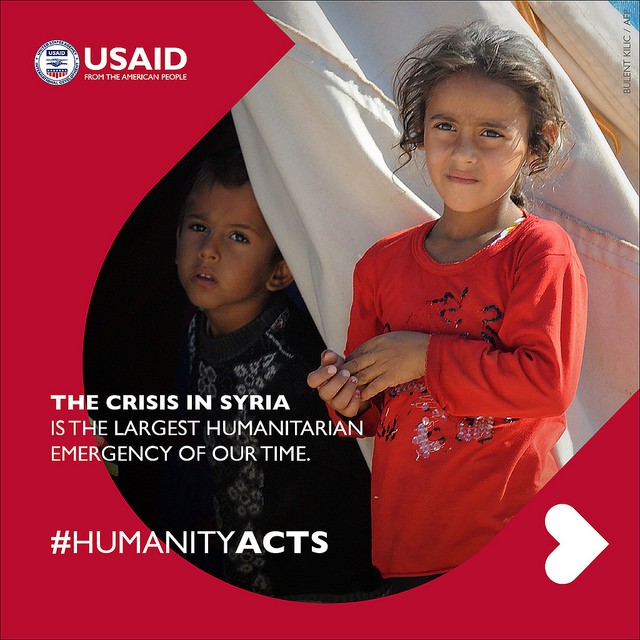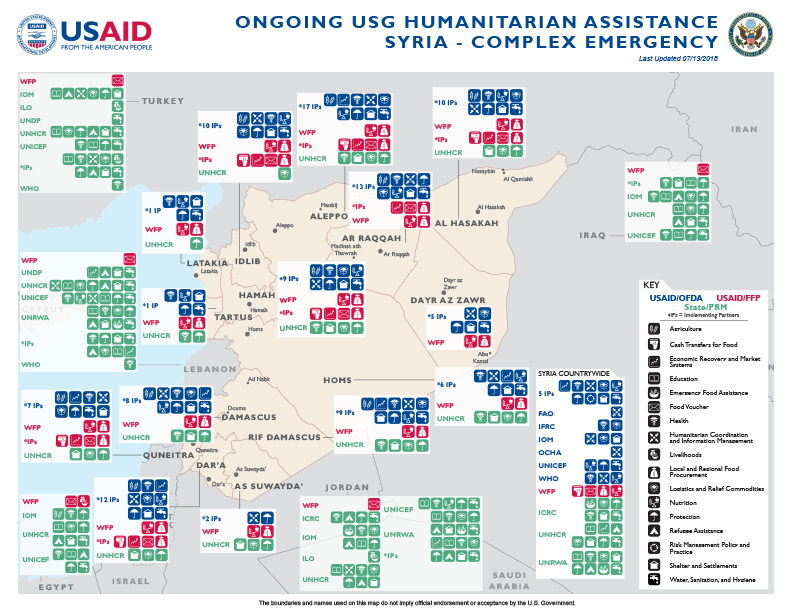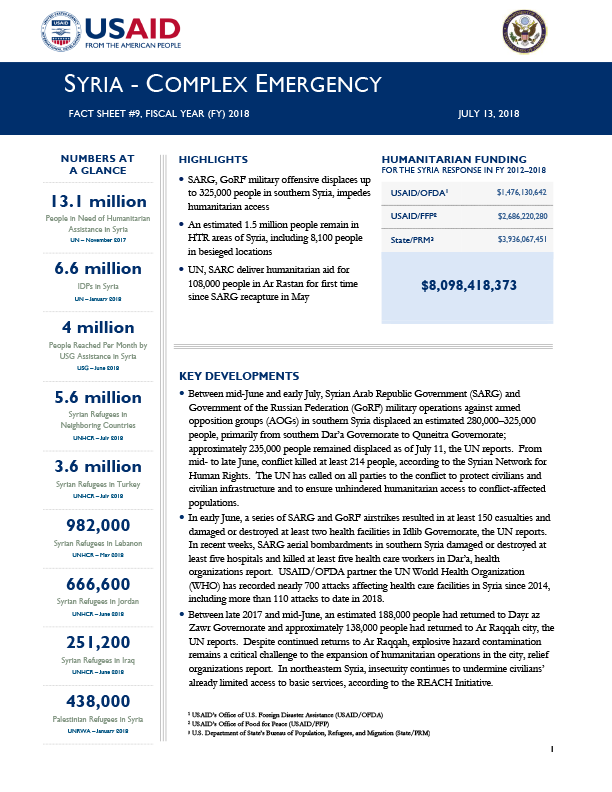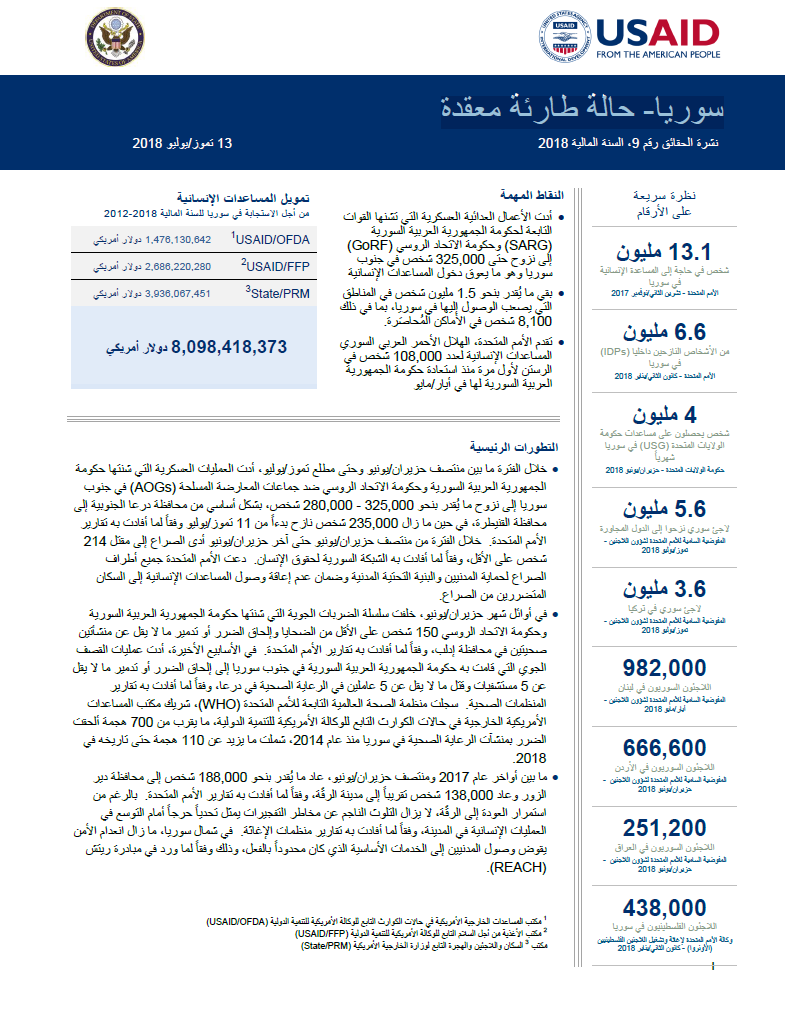- What We Do
- Agriculture and Food Security
- Democracy, Human Rights and Governance
- Economic Growth and Trade
- Education
- Environment and Global Climate Change
- Gender Equality and Women's Empowerment
- Global Health
- Humanitarian Assistance
- Transformation at USAID
- Water and Sanitation
- Working in Crises and Conflict
- U.S. Global Development Lab
Speeches Shim
July 13, 2018
Highlights
SARG, GoRF military offensive displaces up to 325,000 people in southern Syria, impedes humanitarian access
An estimated 1.5 million people remain in HTR areas of Syria, including 8,100 people in besieged locations
UN, SARC deliver humanitarian aid for 108,000 people in Ar Rastan for first time since SARG recapture in May
Key Developments
Between mid-June and early July, Syrian Arab Republic Government (SARG) and Government of the Russian Federation (GoRF) military operations against armed opposition groups (AOGs) in southern Syria displaced an estimated 280,000–325,000 people, primarily from southern Dar’a Governorate to Quneitra Governorate; approximately 235,000 people remained displaced as of July 11, the UN reports. From mid- to late June, conflict killed at least 214 people, according to the Syrian Network for Human Rights. The UN has called on all parties to the conflict to protect civilians and civilian infrastructure and to ensure unhindered humanitarian access to conflict-affected populations.
In early June, a series of SARG and GoRF airstrikes resulted in at least 150 casualties and damaged or destroyed at least two health facilities in Idlib Governorate, the UN reports. In recent weeks, SARG aerial bombardments in southern Syria damaged or destroyed at least five hospitals and killed at least five health care workers in Dar’a, health organizations report. USAID/OFDA partner the UN World Health Organization (WHO) has recorded nearly 700 attacks affecting health care facilities in Syria since 2014, including more than 110 attacks to date in 2018.
Between late 2017 and mid-June, an estimated 188,000 people had returned to Dayr az Zawr Governorate and approximately 138,000 people had returned to Ar Raqqah city, the UN reports. Despite continued returns to Ar Raqqah, explosive hazard contamination remains a critical challenge to the expansion of humanitarian operations in the city, relief organizations report. In northeastern Syria, insecurity continues to undermine civilians’ already limited access to basic services, according to the REACH Initiative.
Syria Complex Emergency -Map #9 FY18 ![]() (pdf - 466k)
(pdf - 466k)
Numbers At A Glance
13.1 million
6.6 million
4 million
5.6 million
3.6 million
982,000
666,600
251,200
438,000
Humanitarian Funding
To Syria Humanitarian Response
FY 2012 - FY 2018
| USAID/OFDA | $1,476,130,642 |
| USAID/FFP | $2,686,220,280 |
| State/PRM | $3,936,067,451 |
| TOTAL | $8,098,418,373 |
Syria Complex Emergency Fact Sheet #9 - 07/13/2018 ![]() (pdf - 232k)
(pdf - 232k)
سوريا حالة طارئة معقدة ![]() (pdf - 532k)
(pdf - 532k)
INSECURITY AND POPULATION DISPLACEMENT
Central and Southern Syria
On July 6, AOGs in eastern Dar’a entered into a ceasefire agreement with the SARG and GoRF following military operations across southern Syria that began on June 17, international media report. As of July 9, the SARG had reportedly recaptured the Nasib–Jaber border crossing between Jordan and Syria and surrounded the AOG-held city of Dar’a, according to international media. Following the SARG’s recapture of Nasib–Jaber, the majority of the 60,000 internally displaced persons (IDPs) gathered in the area relocated to other areas of southern Syria, the UN reports.
The joint SARG–GoRF military campaign displaced an estimated 280,000–325,000 people between mid-June and early July, according to the UN. As of July 11, up to 235,000 people remained displaced, with approximately 160,000 IDPs located near the Golan Heights along the Syria–Israel border. Relief actors, including U.S. Government (USG) partners, are providing assistance to displaced populations, as access allows. As of July 7, USAID/FFP partner the UN World Food Program (WFP) had delivered emergency food and nutrition assistance to support more than 245,000 people affected by conflict in southern Syria. In early July, one State/PRM non-governmental organization (NGO) partner established a mobile clinic to provide emergency, primary, and reproductive health care services to populations along the Syria-Jordan border.
Relief organizations are advocating for the protection of civilians and civilian infrastructure as military operations continue in southern Syria. From mid- to late June, the conflict in southern Syria killed at least 214 people, according to the Syrian Network for Human Rights. In addition, SARG aerial attacks damaged at least five hospitals in Dar’a from June 24–28 and killed at least five health care workers in the governorate, according to health agencies. Meanwhile, an international NGO reports that conflict damaged or destroyed at least three schools in the governorate in late June.
Northwestern Syria
In mid-June, SARG and GoRF airstrikes killed at least 36 people and wounded at least 115 others in Idlib’s towns of Bennsh, Maar Tamsrin, Ram Hamdan, Teftanaz, and Zardana, the UN reports. Airstrikes damaged a medical facility in Bennsh, resulting in the temporary suspension of non-emergency services, as well as a hospital in Teftanaz, rendering the facility inoperable. On June 10, UN Secretary-General António Guterres issued a statement condemning the airstrikes—noting particular concern about allegations that a second strike may have targeted first responders—and calling for an investigation into the attacks. The airstrikes were some of the deadliest in Idlib to date in 2018 and have raised concerns about a potential escalation in violence in the governorate, according to the UN.
Between April 1 and June 17, the Camp Coordination and Camp Management Cluster recorded more than 70,000 primary and secondary displacements in northwestern Syria, primarily from Homs and Rif Damascus governorates. As of June 28, Aleppo Governorate’s Al Bab and A’zaz reception centers and Idlib’s Maaret Elekhwan and Mezanaz reception centers were collectively hosting approximately 2,700 IDPs; State/PRM partner the Office of the UN High Commissioner for Refugees (UNHCR) reports that humanitarian assistance at the reception centers is adequately meeting the needs of IDPs. The UN agency plans to establish additional Rubb halls at the four sites, increasing the total planned and current available capacity of the sites from 13,900 people to 23,000 people.
On May 26, local authorities closed a crossing near Aleppo’s Ibin village, which authorities had opened from May 21– 25 to allow IDPs to return to Aleppo’s Afrin District, the UN reports. As of late May an estimated 3,000 people had returned to Afrin and approximately 134,000 people remained displaced from the district, with the majority located in Aleppo’s Tell Refaat District and Aleppo’s villages of Fafin, Kafr Naseh, Nabul, and Zahraa. The UN reports that humanitarian access in Afrin remains restricted to approximately 10 humanitarian organizations implementing activities in Afrin through cross-border operations from Turkey. The UN continues to advocate for affected populations’ freedom of movement into, from, and within Afrin. Meanwhile, relief agencies and local authorities are restoring access to basic services and delivering assistance to returnees and populations remaining in Afrin District.
Northeastern Syria
On June 17, Syrian Democratic Forces recaptured Dashisha town—located in southeastern Al Hasakah Governorate near the Iraq–Syria border—from the Islamic State of Iraq and Syria (ISIS), international media report. The military campaign, which began in early June, displaced approximately 1,000 civilians from areas of southern Al Hasakah on June 3; as of June 21, approximately 250 IDPs had reached Al Hasakah's Al Hol camp, while additional IDPs were reportedly sheltering in other northeastern Syria IDP camps or with host community members, according to the UN. While displacement remained limited as of mid-June, humanitarian agencies are preparing for the arrival of up to 10,000 IDPs from Dashisha and surrounding areas to Al Hol as military operations continue in the northeast.
Between late 2017 and mid-June, an estimated 188,000 people had returned to Dayr az Zawr, the UN reports. Civilians continue to lack access to basic services, including health care services, which remain insufficient for IDPs sheltering in informal sites, according to a June assessment conducted by the REACH Initiative. In addition, the quality of water remains poor for many households, with households in more than half of the assessed locations reporting waterborne illnesses. Moreover, insecurity related to military operations and explosive hazard contamination continues to exacerbate needs, REACH reports.
Explosive hazard contamination remains a primary risk to populations returning to Ar Raqqah city as well, REACH reports. Access to basic services has marginally improved in the city since March; however, populations continue to experience gaps in health care and sanitation services, according to a June REACH assessment. In addition, significant conflict-related damage to shelter and infrastructure continues to pose challenges for returnees. Approximately 138,000 people returned to Ar Raqqah city between October 2017 and mid-June, the UN reports.
HUMANITARIAN ACCESS
Approximately 1.5 million people were residing in UN-identified besieged and hard-to-reach (HTR) areas of Syria as of June 20, representing a decrease of approximately 27 percent—or 550,000 people—since April, the UN reports. The SARG’s recapture of southern Damascus, as well as implementation of a local agreement between AOGs and the SARG and GoRF in northern rural Homs in May, likely contributed to the decline in populations living in HTR areas. Additionally, following the SARG’s recapture of Rif Damascus’ Eastern Ghouta region in mid-April, only Idlib’s towns of Foah and Kafraya—where an estimated 8,100 people resided as of late June—remained designated by the UN as besieged.
While the UN continues to provide assistance to Eastern Ghouta through its partnership with the Syrian Arab Red Crescent (SARC), the SARG had not permitted the UN access to provide additional assistance as of early July. On July 1, the UN and SARC conducted a convoy delivering emergency food, health, nutrition, and WASH assistance to approximately 25,000 people in Eastern Ghouta’s Douma town. As part of the convoy, WFP delivered food rations and wheat flour sufficient for 24,600 people. The July convoy supplements a mid-June SARC convoy that delivered emergency relief items and food assistance to approximately 60,000 people in Douma. The UN continues to advocate for unhindered humanitarian access to the 125,000 people estimated to reside in the region, including approximately 16,000 people who returned to Eastern Ghouta between mid-May and early June.
On June 27, a UN and SARC humanitarian convoy delivered emergency food, health, nutrition, and WASH assistance to approximately 108,000 people in northern rural Homs’ HTR town of Ar Rastan. The convoy represents the first UN delivery of humanitarian assistance to Ar Rastan since the SARG regained control of the town in early May. The UN had last reached Ar Rastan in October 2017.
Commissioner-General Pierre Krähenbühl of the UN Relief and Works Agency for Palestine Refugees in the Near East (UNRWA) visited the unofficial Yarmouk Palestinian refugee camp in southern Damascus on July 3, the first senior UN official to access the camp in several years. Recent conflict in Yarmouk destroyed more than 70 percent of the camp, which is a UN-identified HTR area.
AGRICULTURE AND FOOD SECURITY
Yields from northern Syria’s May-to-July cereal harvest are anticipated to be significantly below average, according to the European Commission Joint Research Center. While below-average rainfall in early 2018 delayed sowing in some areas, the UN Food and Agriculture Organization reports that conflict-related constraints—including high production costs, lack of agricultural inputs, and damaged or destroyed infrastructure, such as irrigation systems—limited agricultural production in northern Syria, particularly in Al Hasakah and Dayr az Zawr.
During May, WFP coordinated with other food security organizations to respond to the needs of more than 35,000 people who evacuated northern Homs to Idlib and western Aleppo. Through cross-border operations from Turkey, the UN agency distributed emergency food assistance to an estimated 21,000 people in the two governorates. In addition, WFP pre-positioned approximately 30,000 ready-to-eat rations, each sufficient for five people for five days, enabling the UN agency to address the immediate food needs of approximately 150,000 people in the two governorates.
HEALTH AND PROTECTION
From March 10–June 24, health agencies recorded nearly 580 cases of acute watery diarrhea in Dayr az Zawr, including 12 related deaths. In mid-June, USG partners WHO and the UN Children’s Fund (UNICEF) traveled to affected areas of Dayr az Zawr along the Euphrates River to assess disease surveillance efforts, evaluate response activities and needs, and investigate the source of water contamination. UNICEF and WHO continue to conduct water treatment activities, perform water quality testing, and deliver safe drinking water to affected populations.
As of June 30, between 1,500 and 1,700 Palestinian refugees sheltering in abandoned buildings in Rif Damascus’ towns of Babella, Beit Sahm, and Yalda were at imminent risk of eviction as building residents begin returning to the towns and implement rent requirements for refugees to remain in the buildings. However, alternative housing options remain limited due to financial constraints and movement restrictions for the Palestinian refugees, who were displaced from southern Damascus’ unofficial Yarmouk camp. In May, State/PRM partner UNRWA decreased its emergency cash distributions to Palestinian refugees in Syria due to lack of funding, reducing the monthly assistance from $32 to $23 per person. Palestinian refugees in Yalda have also lost assets and experienced economic instability due to the previous conflict in Yarmouk, which destroyed more than 70 percent of the camp and resulted in their subsequent displacement to Yalda.
RELIEF COMMODITIES AND SHELTER
From June 27–28, UNRWA provided humanitarian assistance—including blankets, food, hygiene kits, and mattresses—to approximately 3,000 Palestinian refugees and Syrians sheltering in Yalda who were displaced from Yarmouk. The delivery represents the third time the UN has accessed the town since May 2016; the UN and SARC previously reached the area on June 14, delivering humanitarian assistance to nearly 51,000 people in Babella, Beit Sahm, and Yalda towns.
PUBLIC DONATION INFORMATION
The most effective way people can assist relief efforts is by making cash contributions to humanitarian organizations that are conducting relief operations. A list of humanitarian organizations that are accepting cash donations for disaster responses around the world can be found at www.usaid.gov/crisis/syria.
The USG encourages cash donations because they allow aid professionals to procure the exact items needed (often in the affected region); reduce the burden on scarce resources (such as transportation routes, staff time, and warehouse space); can be transferred very quickly and without transportation costs; support the economy of the disaster-stricken region; and ensure culturally, dietary, and environmentally appropriate assistance.





Comment
Make a general inquiry or suggest an improvement.